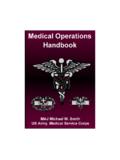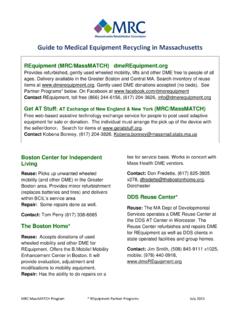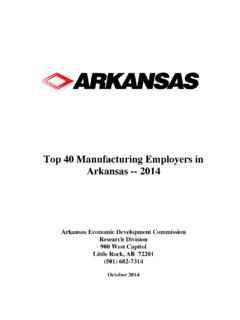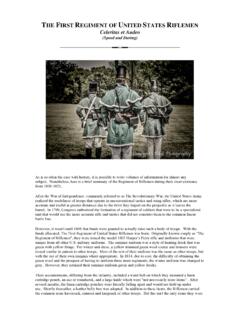Transcription of Tillage Equipment - USDA
1 Tillage Equipment Pocket Identification GuideTillage Systems-Primary Tillage - Secondary Tillage -Fertilizer/Manure-Combination Tools- Other-October 2010 About this purpose of the guide is to help you identify commonly used farm Equipment . Its color photos and line drawingswill facilitate communication between NRCS and our clients by providing common definitions and RUSLE2 Universal Soil Loss Equation, Version 2 (RUSLE2), wasdeveloped primarily to guide conservation planning, inventory erosion rates and estimate sediment delivery. Values computed byRUSLE2 are supported by accepted scientific knowledge and techni-cal judgment, are consistent with sound principles of conservationplanning, and result in good conservation different systems reviewed in this guide are color page boarder colors will group the different systems together: Tillage Systems-greenFertilizer/Manure-brown Primary Tillage -redCombination Tools-blueSecondary Tillage -yellowOther-orangeMulch-Till Planting SystemMulch-till planting will leave varying residue levels afterplanting depending upon the number of Tillage passes and thelevel of soil Planting SystemMulch-till - The soil is disturbed the full width prior toplanting.
2 Tillage tools such as chisels, field cultivators or disksare used full width. Weed control is accomplished with herbicidesand/or planting with residue. Long term, no-till is aneffective erosion control and significantly reduces surfacerunoff. This reduces sediment and nutrient loading of lakes andstreams, which improves water quality and reduces Planting SystemNo-Till Planting SystemNo-till - The soil is left undisturbed from harvest to plantingexcept for nutrient injection. Planting or drilling is accomplishedin a narrow seedbed or slot created by coulters, row cleaners ordisk openers. Weed control is accomplished primarily with herbi-cides. Cultivation may be used for emergency weed control. Ridge-Till Planting SystemRidge-till - The soil isleft undisturbed fromharvest to is completed in aseedbed prepared onridges with sweeps, diskopeners, coulters, or rowcleaners.
3 Residue is lefton the surface betweenridges. Weed control isaccomplished with herbi-cides and/or are rebuilt and Zone-Till Planting SystemSeedbed preparation is completed in a narrow band no more than1/3 of the row width. It may be completed in the fall with the appli-cation of nutrient or at planting time. Crop residue and soil con-solidation is left undisturbed between the seedbed and Zone-Till Planting SystemThe Chisel Plow components may include various types ofsweeps, spikes and shovels attached to the shanks. In the Midwest,many producers use 2-inch wide reversible-point spikes or 4-inch wide twisted shovels. Spikes and sweeps do less soil mixingand cover less residue than do twisted chisel plows are equipped with a gang of coulters or diskblades mounted in front to cut residue. Chisel Plow Reduced Tillage isusually done with achisel plow andleaves 15% to 30%residue coverage onthe Plow The selection of the specific primary Tillage tooland type of points or blades is important to the suc-cess of mulch-till systems.
4 Generally, the less inver-sion action the point or shovel creates, the lessresidue is buried. Chisel Plow Primary Tillage implement used in the fall that breaks andshatters the soil leaving it rough with residue on or near thesurface. Operating depth ranges from 6 to 12 inches. RUSLE2 - Chisel, straight pointsChisel with SweepsRUSLE2 - Chisel, Sweep ShovelChisel PointsA. 2 reversible pikepointB. 2 reversible Straight Chisel PointC. 3 right and left twisted shovels PointsD. 4-1/2 reversible shovelE. 8 or 10 shovelsF. 12 , 14 , 16 , or 18 sweepsSweeps and spike points bury less residue than do straightpoints or twisted points. Slower speeds and shallower operatingdepths usually leave more (A) 3 inch twisted(D) Sweep(B) 3inch straight(E) 4 1/2 inch wide twisted(C) 2 inch wide Straight(F) 4 1/2 inch straight pointChisel PointsDiskA disk is a Tillage implement that pulverizes or smooths thesoil.
5 Its concave cutting blades are mounted on a common shaft toform a gang. A disk consists of two or more gangs attached to aframe. The operating depth is usually one quarter of the diskdiameter. Offset diskis used for is used forboth primary andsecondary - disk, offsetRUSLE2 - disk tandemDisk, tandemRUSLE2 - Disk, TandemHeavy Offset DiskSometimes called a plowing disk, this disk uses its weightand large diameter blades to slice and turn soil and residue. Itdoes extensive soil disturbance and residue burial. RUSLE2 - Disk, offset, heavy 15 inch depthDisk - Tandem Light FinishThe tandem light finish tool provides less soil disturbancethan the offset disk, leaving more residue on the soil amount of residue left on the soil surface depends upon thedepth of Tillage , speed and moisture content of the soil at thetime of - Disk, tandem light finishPara-plowThe purpose of the Para-plow is to loosen compacted soillayers 12 to 16 inches deep and still maintain high surfaceresidue levels.
6 The Para-plow lifts and fractures the - Para-plow or para-tillPara-PlowSurface residue is left onthe soil surface as the soil islifted and fractured - moldboardRUSLE2 - Plow, moldboardThe moldboard plow thoroughly lifts and invertsthe soil leaving very little residue on the soil - MoldboardThe subsoiler is a primary Tillage tool, used in the fall, that issimilar to a chiselplow. It is typicallydesigned to pene-trate 12 to 22 inchesdeep to alleviate soilcompaction. Subsoiling isoften used to loosencompacted areas offields where heavyloads have amount of distur-bance will depend upon the shape of the shank and the workingangle of the tool bar. In-Row Subsoilers do less soil disturbance than a conventionalsubsoiler or V-Ripper. Use Subsoiler, in-row for the RUSLE2operation when using subsoilers that do little disturbance of sur-face residue.
7 V-RipperRUSLE2 - SubsoilerSubsoiler/V-RipperSubsoiler/Sha nksSubsoiler shanks:(a) straight(b) parabolic(c) bent legabcABAerWay While maintaining surface residue, Shattertines crackand shatter compacted soil 8 inches to open new channelsfor air and water. RUSLE2 - Aerator, field surface, ground drivenAerWay AerWay shattertines liftand fracture the soil to increaseair and water movement. Field Cultivator with Harrow AttachmentA field cultivator is designed for light Tillage and field fin-ishing. Usually they are used for secondary Tillage and forincorporating herbicides. Spiked point field cultivators do lit-tle soil mixing and leave more residue on the RUSLE2 Calculations this is two operations cultivator,field with 6-12 inch shovels and spiked tooth - Cultivator, field with 6-12 inch ShovelC and Spiked Tooth Harrow AttachmentField Cultivator with Coiled Tine HarrowField Cultivator - SweepsField cultivators equippedwith sweeps do extensive hor-izontal and vertical soil mix-ing.
8 Sweeps are the choicefor herbicide bury more residuethan field cultivatorsequipped with spiked - Cultivator, field 6-12 inch sweepsField Cultivator - SweepsFor RUSLE 2 calculations, this is two operations cultivator, field 6-12 inch sweeps with harrow coiled 2 - Cultivator, Field 6-12 inchsweeps with harrow coiled tineRolling CultivatorA Rolling cultivator uses two spidergangs on each row assembly. It operates inheavy residue without - Cultivator, rotaryRolling CultivatorRUSLE2 - Rolling Basket IncorporateRow CultivatorRow cultivators kill weeds while preserving the crop. RUSLE2 - Cultivator, rowRow CultivatorRUSLE2 - Cultivator, row, high residueHarrowsHarrows are primarily used to level the soil surface, redis-tribute surface residue, pulverize clods and disturb germinationofweeds. Harrows are often attached to the rear of disks, fieldcultivators, or drills to smooth and firm the soil surface andredistribute - Harrow, Coiled TinePasture Harrow used to distributemanureCoiled TineHarrowHarrowsSpikedTooth HarrowHarrow/Phillipstmthe PhillipstmRotaryHarrow works in the top inch or so toprepare seedbeds.
9 It redistributes residue and levels the ground.(*Depending upon the type of residue present, use Harrow Rotaryfor heavy, nonfragile residue such as corn and Harrow RotaryLight Fluff Fragile for light residue such as soybeans.)RUSLE2 - Harrow, Rotary (*or Harrow Rotary Light Fluff Fragile)Harrow/PhillipstmTines disturb only the top inch or so of soil. In general, thegreater a tool is angled off the tool bar, the more that operationwill disturb the soil. The Phillipstmharrow is permanently set ata 45degree angle. (Depending on the type of residue present, useHarrow Rotary for heavy, nonfragile residue such as corn, andharrow Rotary Light Fluff Fragile for light residue such as soybeans.)RUSLE2 - Harrow, Rotary (*or Harrow Rotary Light Fluff Fragile)Harrow/Phoenix The phoenix harrow is a high residue Tillage tool that dis-turbs the soil.
10 5 to 2 inches deep, leaving most of the residue onthe soil surface. The greater the harrow is angled off the toolbar, the more the operation will disturb the soil. RUSLE2 - Harrow, Rotary (*or Harrow Rotary Light Fluff Fragile)The phoenix harrow isused to mix the top inch ofsoil surface to incorporateherbicides and level theground. The angle may beadjusted from 20 to 45degrees. Harrow/Phoenix Rotary HoeA rotaryhoe consists of one or two staggeredgangs of spider-like wheels about to 4 inches is a fast, economical way to control small weeds andbreak surface crust to improve crop emergence. RUSLE2 - Rotary HoeRotary HoeFertilizer Application - Anhydrous AmmoniaFertilizer Application - Anhydrous AmmoniaIn the midwest anhydrous ammoniacomprises the majority of commercialnitrogen application. Anhydrous ammo-nia must be injected into the soil.



















